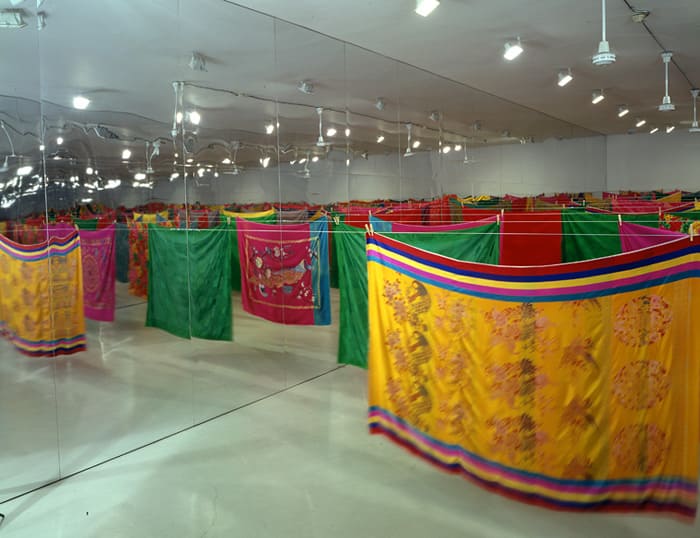《김수자》피터 블럼 갤러리 전시
2002
-
1998년부터 뉴욕에서 활동해 온 김수자는 이번 전시에서 <거울여인>이라는 새로운 설치 작품을 선보였다. 작년에 P.S. 1과 올해 휘트니 비엔날레에서 선보인 매혹적인 영상 작품 <바늘여인>으로 많은 찬사를 받았던 이 작가는, 그녀의 작품이 일상생활의 모습에 너무 가깝기 때문에 고국인 한국에서는 예술로 여겨지지 않는 경우가 있다고 말했다. 이번 전시에서 김수자는 “ 당신이 지금까지 보아온 중 가장 멋진 빨래의 방”이라 할 수 있는 작품을 선보였다. 총 14열로 나란히 늘어선 화려한 색상의 실크 혼례 이불이 빨랫줄에 고정된 채 전시 공간을 가로지르고 있었고, 바닥에서 천장까지 벽 전체에는 거울이 설치되었다. 이불보는 봉황, 용, 과일, 꽃 등 장수와 다산을 상징하는 문양에는 정교하게 수놓아져 있었으며, 자홍, 진녹, 연노랑, 감청, 황금, 진자두, 진분홍, 선홍 등 선명한 색의 조화가 축제와 같은 분위기를 자아냈고, 그의 설치물은 거울을 통해 끝없이 반복되며 확장되었다.
-
이불보는 한국에서 전통적으로 신혼부부에게 선물로 주던 것으로, 필요시에는 접어서 들고 떠날 수 있는 가정용 물품이다. 실제로 마치 텐트처럼 임시 거처를 만들 수 있는 이 이불보는 여성이 수 세기 동안 수행해 온 전통적 가사노동의 상징적 복합체이다. 그들은 빨래를 널고, 자신이 짜고 장식한 직물을, 단순한 가사 노동을 넘어선 예술적, 명상적 행위로 인식하며 섬세하게 돌본다. 작가는 이를 두고 "근원적 장소"라 말한다. 이 이불보들은 혼례 이불과 수의, 탄생과 죽음, 사랑과 고통, 희망과 절망, 수면과 각성, 환생과 꿈의 순환을 담고 있다. 이는 여성의 삶을 섬세하고도 포괄적으로 조망하는 장치이다.
-
설치된 이불보는 첫 번째 열과 마지막 두 줄을 제하고는 모두 쌍을 이루어 걸려 있으며, 전략적으로 배치됐다. 설치 공간에 들어서면, 마치 한 폭의 그림 속에 들어가는 듯한 경험이 시작된다. 미로를 연상시키는 공간을 통과하면서 관객은 스스로 길을 선택해야 했고, 그 동선은 매우 상징적이면서도 일상적인 통과 의례처럼 부드럽게 조정된다. 눈에 잘 띄지 않는 작은 천장팬 바람에 너울대는 비단은 생명의 숨결인 ‘기(氣)’에 의해 움직이는 듯 보인다. 색색의 평면에 둘러싸인 관객은, 희미하게 들려오는 티베트의 만트라 독경 소리와 간헐적으로 울리는 종소리에 위안을 느낀다. 이는 어쩌면 영적인 형태의 베갯머리 대화라 해도 좋을 것이다. 정교하게 배열된 거울을 통해 전달되는 이 작품은 아시아 불교의 시각을 바탕으로 한, 부드럽고 사려 깊으며, 자기 인식적인 페미니즘의 표현이다.
- — 『아트 인 아메리카』, 2002년 9월호, 번역(한국문화예술위원회 후원): 이재희
 A Mirror Woman, 2002. Korean bedcovers, mirror structure walls, 4 fans, cables, clothespins, Tibetan monk chant. Installation view at Peter Blum Gallery, New York, 2002. Photo by Bill Orcutt.
A Mirror Woman, 2002. Korean bedcovers, mirror structure walls, 4 fans, cables, clothespins, Tibetan monk chant. Installation view at Peter Blum Gallery, New York, 2002. Photo by Bill Orcutt.
Kim Sooja at Peter Blum
Lilly Wei (Independent Curator)
2002
-
New York-based since 1998, Kim Sooja here exhibited a new installation titled A Mirror Woman. The artist, who was much praised last year for her riveting video A Needle Woman, seen at P.S.1 and later at this year's Whitney Biennial, has said that in her native Korea, her work is sometimes not seen as art, since it so closely approximates the look of daily life. For this show, she presented the best-looking room of laundry you're ever likely to see: gaily colored silk bedspreads, 14 rows deep, pinned to clothes-lines strung across the gallery, whose walls had been mirrored from floor to ceiling for the occasion. The coverlets, elaborately embroidered with phoenixes, dragons, fruits and flowers — symbols of long life and fertility — were strikingly festive, with their high-pitched color schemes of fuchsia, emerald green, sour lime, royal blue, golden yellow, ripe plum, hot pink and cherry red. The mirrors extended the installation in endless, repetitive sequences.
-
Traditionally given as gifts to newly married couples, these salvaged wedding bedspreads are domestic objects that can be folded, wrapped and carried away, if need be; indeed, like tents, these covers can create a dwelling, an emblematic compound of sorts, in which women perform centuries-old, conventional domestic tasks, like hanging out the wash, attending to fabrics they have woven and embellished in considered acts of art and meditation. "A fundamental site," the artist says, "these bedcovers refer to marriage beds and shrouds, birth and death, love and pain, hope and despair, sleep and awakenings, cycles of incarnation and dreams, a delicate but comprehensive view of a woman's world."
-
Hung, with the exception of the first and the last two rows, in pairs, the bedcovers were strategically positioned. Entering the installation was a little like entering a painting. As you negotiated the space, which resembled a maze, you had to choose your route, your subsequent progress gently controlled in a ritual of passage both profoundly symbolic and quite ordinary. Small unobtrusive ceiling fans set the silk aflutter as if it were animated by chi, the breath of life. Encompassed by planes of color, you were soothed by the faint hum of recorded Tibetan mantras interrupted by the tinkling of bells — a spiritual version of pillow talk, perhaps. This was a comely, courteous kind of feminism, from an Asian Buddhist perspective seen lightly, self-consciously, through artfully arrayed mirrors.
-
— From Art in America, September 2002
-
Lilly Wei is a New York-based independent curator, essayist and critic who writes for several publications in the United States and abroad. A frequent contributor to Art in America, she is also a contributing editor at ARTnews and Art Asia Pacific.